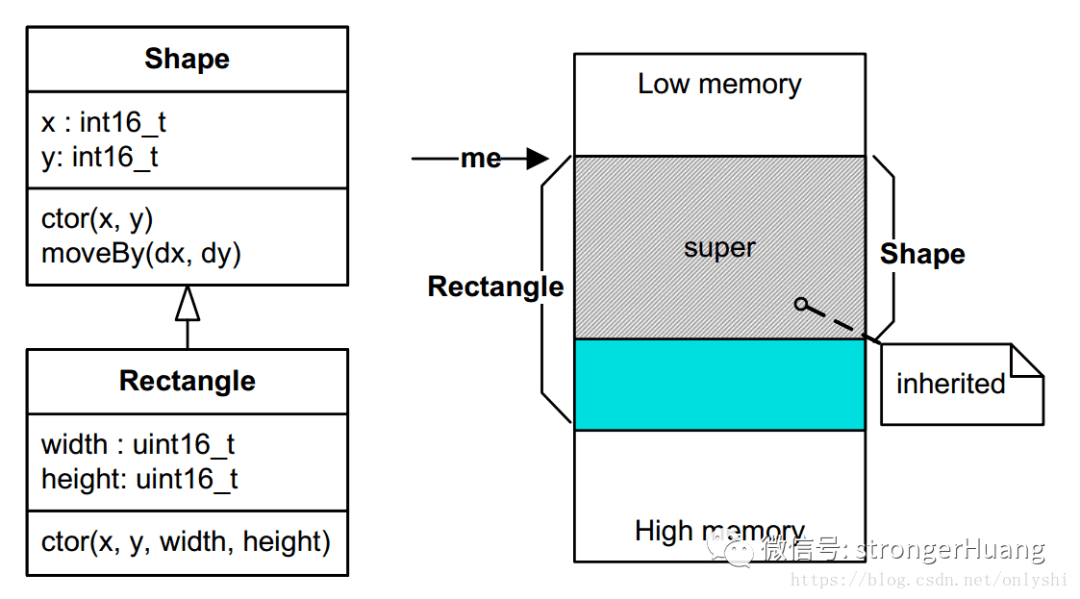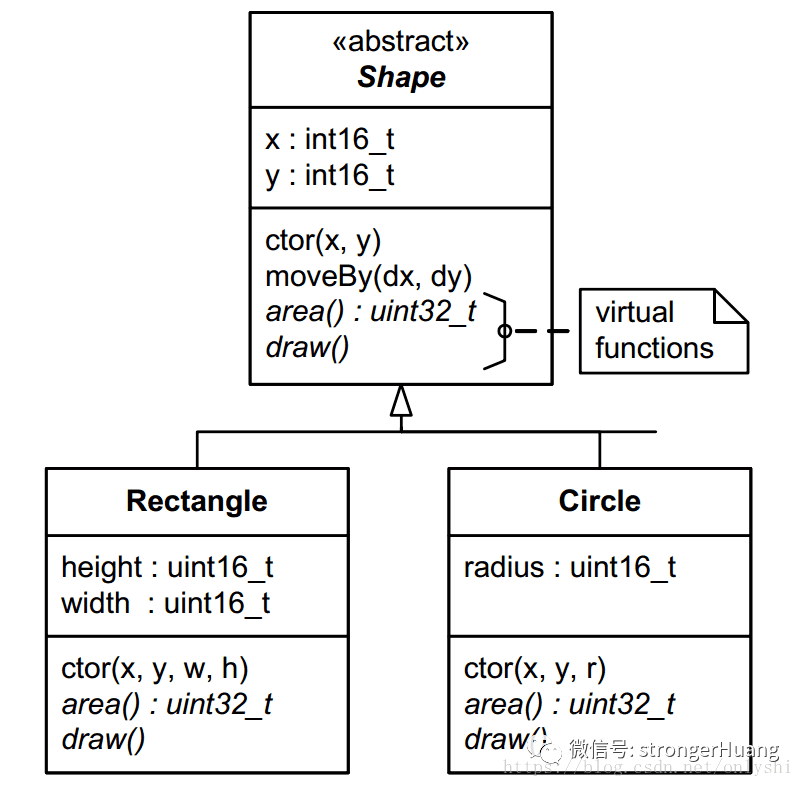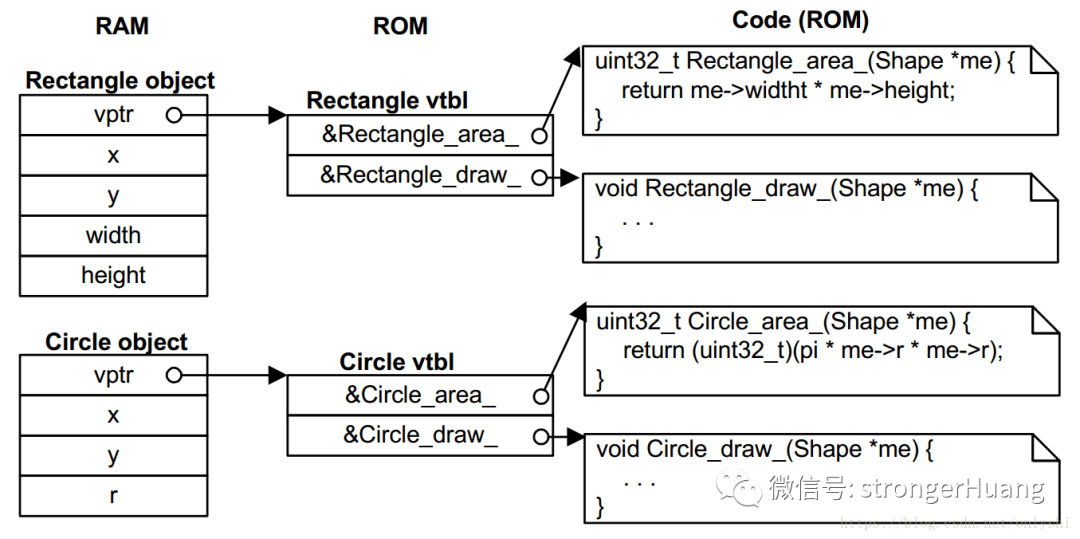C語言的高級用法,面向對象
不知道有多少人去了解過語言的發展史,早期C語言的語法功能其實比較簡單。隨著應用需求和場景的變化,C語言的語法功能在不斷升級變化。
雖然我們的教材有這么一個結論:C語言是面向過程的語言,C++是面向對象的編程語言,但面向對象的概念是在C語言階段就有了,而且應用到了很多地方,比如某些操作系統內核、通信協議等。
面向對象編程,也就是大家說的OOP(Object Oriented Programming)并不是一種特定的語言或者工具,它只是一種設計方法、設計思想,它表現出來的三個最基本的特性就是封裝、繼承與多態。
1、為什么用C實現OOP閱讀文本之前肯定有讀者會問這樣的問題:我們有C++面向對象的語言,為什么還要用C語言實現面向對象呢?
C語言這種非面向對象的語言,同樣也可以使用面向對象的思路來編寫程序的。
只是用面向對象的C++語言來實現面向對象編程會更簡單一些,但是C語言的高效性是其他面向對象編程語言無法比擬的。
當然使用C語言來實現面向對象的開發相對不容易理解,這就是為什么大多數人學過C語言卻看不懂Linux內核源碼。
所以這個問題其實很好理解,只要有一定C語言編程經驗的讀者都應該能明白:面向過程的C語言和面向對象的C++語言相比,代碼運行效率、代碼量都有很大差異。在性能不是很好、資源不是很多的MCU中使用C語言面向對象編程就顯得尤為重要。
要想使用C語言實現面向對象,首先需要具備一些基礎知識。比如:(C語言中的)結構體、函數、指針,以及函數指針等,(C++中的)基類、派生、多態、繼承等。
首先,不僅僅是了解這些基礎知識,而是有一定的編程經驗,因為上面說了“面向對象是一種設計方法、設計思想”,如果只是停留在字面意思的理解,沒有這種設計思想肯定不行。
因此,不建議初學者使用C語言實現面向對象,特別是在真正項目中。建議把基本功練好,再使用。
利用C語言實現面向對象的方法很多,下面就來描述最基本的封裝、繼承和多態。
3、封裝封裝就是把數據和函數打包到一個類里面,其實大部分C語言編程者都已近接觸過了。
C 標準庫中的 fopen(), fclose(), fread(), fwrite()等函數的操作對象就是 FILE。數據內容就是 FILE,數據的讀寫操作就是 fread()、fwrite(),fopen() 類比于構造函數,fclose() 就是析構函數。
這個看起來似乎很好理解,那下面我們實現一下基本的封裝特性。
#ifndef SHAPE_H
#define SHAPE_H
#include <stdint.h>
// Shape 的屬性
typedef struct {
int16_t x;
int16_t y;
} Shape;
// Shape 的操作函數,接口函數
void Shape_ctor(Shape * const me, int16_t x, int16_t y);
void Shape_moveBy(Shape * const me, int16_t dx, int16_t dy);
int16_t Shape_getX(Shape const * const me);
int16_t Shape_getY(Shape const * const me);
#endif /* SHAPE_H */這是 Shape 類的聲明,非常簡單,很好理解。一般會把聲明放到頭文件里面 “Shape.h”。來看下 Shape 類相關的定義,當然是在 “Shape.c” 里面。
#include "shape.h"
// 構造函數
void Shape_ctor(Shape * const me, int16_t x, int16_t y)
{
me->x = x;
me->y = y;
}
void Shape_moveBy(Shape * const me, int16_t dx, int16_t dy)
{
me->x += dx;
me->y += dy;
}
// 獲取屬性值函數
int16_t Shape_getX(Shape const * const me)
{
return me->x;
}
int16_t Shape_getY(Shape const * const me)
{
return me->y;
}再看下 main.c
#include "shape.h" /* Shape class interface */
#include <stdio.h> /* for printf() */
int main()
{
Shape s1, s2; /* multiple instances of Shape */
Shape_ctor(&s1, 0, 1);
Shape_ctor(&s2, -1, 2);
printf("Shape s1(x=%d,y=%d)n", Shape_getX(&s1), Shape_getY(&s1));
printf("Shape s2(x=%d,y=%d)n", Shape_getX(&s2), Shape_getY(&s2));
Shape_moveBy(&s1, 2, -4);
Shape_moveBy(&s2, 1, -2);
printf("Shape s1(x=%d,y=%d)n", Shape_getX(&s1), Shape_getY(&s1));
printf("Shape s2(x=%d,y=%d)n", Shape_getX(&s2), Shape_getY(&s2));
return 0;
}編譯之后,看看執行結果:
Shape s1(x=0,y=1) Shape s2(x=-1,y=2) Shape s1(x=2,y=-3) Shape s2(x=0,y=0)
整個例子,非常簡單,非常好理解。以后寫代碼時候,要多去想想標準庫的文件IO操作,這樣也有意識的去培養面向對象編程的思維。
4、繼承 繼承就是基于現有的一個類去定義一個新類,這樣有助于重用代碼,更好的組織代碼。在 C 語言里面,去實現單繼承也非常簡單,只要把基類放到繼承類的第一個數據成員的位置就行了。例如,我們現在要創建一個 Rectangle 類,我們只要繼承 Shape 類已經存在的屬性和操作,再添加不同于 Shape 的屬性和操作到 Rectangle 中。
下面是 Rectangle 的聲明與定義:
#ifndef RECT_H
#define RECT_H
#include "shape.h" // 基類接口
// 矩形的屬性
typedef struct {
Shape super; // 繼承 Shape
// 自己的屬性
uint16_t width;
uint16_t height;
} Rectangle;
// 構造函數
void Rectangle_ctor(Rectangle * const me, int16_t x, int16_t y,
uint16_t width, uint16_t height);
#endif /* RECT_H */#include "rect.h"
// 構造函數
void Rectangle_ctor(Rectangle * const me, int16_t x, int16_t y,
uint16_t width, uint16_t height)
{
/* first call superclass’ ctor */
Shape_ctor(&me->super, x, y);
/* next, you initialize the attributes added by this subclass... */
me->width = width;
me->height = height;
}我們來看一下 Rectangle 的繼承關系和內存布局:

因為有這樣的內存布局,所以你可以很安全的傳一個指向 Rectangle 對象的指針到一個期望傳入 Shape 對象的指針的函數中,就是一個函數的參數是 “Shape *”,你可以傳入 “Rectangle *”,并且這是非常安全的。這樣的話,基類的所有屬性和方法都可以被繼承類繼承!
#include "rect.h"
#include <stdio.h>
int main()
{
Rectangle r1, r2;
// 實例化對象
Rectangle_ctor(&r1, 0, 2, 10, 15);
Rectangle_ctor(&r2, -1, 3, 5, 8);
printf("Rect r1(x=%d,y=%d,width=%d,height=%d)n",
Shape_getX(&r1.super), Shape_getY(&r1.super),
r1.width, r1.height);
printf("Rect r2(x=%d,y=%d,width=%d,height=%d)n",
Shape_getX(&r2.super), Shape_getY(&r2.super),
r2.width, r2.height);
// 注意,這里有兩種方式,一是強轉類型,二是直接使用成員地址
Shape_moveBy((Shape *)&r1, -2, 3);
Shape_moveBy(&r2.super, 2, -1);
printf("Rect r1(x=%d,y=%d,width=%d,height=%d)n",
Shape_getX(&r1.super), Shape_getY(&r1.super),
r1.width, r1.height);
printf("Rect r2(x=%d,y=%d,width=%d,height=%d)n",
Shape_getX(&r2.super), Shape_getY(&r2.super),
r2.width, r2.height);
return 0;
}輸出結果:Rect r1(x=0,y=2,width=10,height=15) Rect r2(x=-1,y=3,width=5,height=8) Rect r1(x=-2,y=5,width=10,height=15) Rect r2(x=1,y=2,width=5,height=8)5、多態 C++ 語言實現多態就是使用虛函數。在 C 語言里面,也可以實現多態。
現在,我們又要增加一個圓形,并且在 Shape 要擴展功能,我們要增加 area() 和 draw() 函數。但是 Shape 相當于抽象類,不知道怎么去計算自己的面積,更不知道怎么去畫出來自己。而且,矩形和圓形的面積計算方式和幾何圖像也是不一樣的。
下面讓我們重新聲明一下 Shape 類:
#ifndef SHAPE_H
#define SHAPE_H
#include <stdint.h>
struct ShapeVtbl;
// Shape 的屬性
typedef struct {
struct ShapeVtbl const *vptr;
int16_t x;
int16_t y;
} Shape;
// Shape 的虛表
struct ShapeVtbl {
uint32_t (*area)(Shape const * const me);
void (*draw)(Shape const * const me);
};
// Shape 的操作函數,接口函數
void Shape_ctor(Shape * const me, int16_t x, int16_t y);
void Shape_moveBy(Shape * const me, int16_t dx, int16_t dy);
int16_t Shape_getX(Shape const * const me);
int16_t Shape_getY(Shape const * const me);
static inline uint32_t Shape_area(Shape const * const me)
{
return (*me->vptr->area)(me);
}
static inline void Shape_draw(Shape const * const me)
{
(*me->vptr->draw)(me);
}
Shape const *largestShape(Shape const *shapes[], uint32_t nShapes);
void drawAllShapes(Shape const *shapes[], uint32_t nShapes);
#endif /* SHAPE_H */看下加上虛函數之后的類關系圖:

5.1 虛表和虛指針
虛表(Virtual Table)是這個類所有虛函數的函數指針的集合。
虛指針(Virtual Pointer)是一個指向虛表的指針。這個虛指針必須存在于每個對象實例中,會被所有子類繼承。
在《Inside The C++ Object Model》的第一章內容中,有這些介紹。
5.2 在構造函數中設置vptr
在每一個對象實例中,vptr 必須被初始化指向其 vtbl。最好的初始化位置就是在類的構造函數中。事實上,在構造函數中,C++ 編譯器隱式的創建了一個初始化的vptr。在 C 語言里面, 我們必須顯示的初始化vptr。
下面就展示一下,在 Shape 的構造函數里面,如何去初始化這個 vptr。
#include "shape.h"
#include <assert.h>
// Shape 的虛函數
static uint32_t Shape_area_(Shape const * const me);
static void Shape_draw_(Shape const * const me);
// 構造函數
void Shape_ctor(Shape * const me, int16_t x, int16_t y)
{
// Shape 類的虛表
static struct ShapeVtbl const vtbl =
{
&Shape_area_,
&Shape_draw_
};
me->vptr = &vtbl;
me->x = x;
me->y = y;
}
void Shape_moveBy(Shape * const me, int16_t dx, int16_t dy)
{
me->x += dx;
me->y += dy;
}
int16_t Shape_getX(Shape const * const me)
{
return me->x;
}
int16_t Shape_getY(Shape const * const me)
{
return me->y;
}
// Shape 類的虛函數實現
static uint32_t Shape_area_(Shape const * const me)
{
assert(0); // 類似純虛函數
return 0U; // 避免警告
}
static void Shape_draw_(Shape const * const me)
{
assert(0); // 純虛函數不能被調用
}
Shape const *largestShape(Shape const *shapes[], uint32_t nShapes)
{
Shape const *s = (Shape *)0;
uint32_t max = 0U;
uint32_t i;
for (i = 0U; i < nShapes; ++i)
{
uint32_t area = Shape_area(shapes[i]);// 虛函數調用
if (area > max)
{
max = area;
s = shapes[i];
}
}
return s;
}
void drawAllShapes(Shape const *shapes[], uint32_t nShapes)
{
uint32_t i;
for (i = 0U; i < nShapes; ++i)
{
Shape_draw(shapes[i]); // 虛函數調用
}
}5.3 繼承 vtbl 和 重載 vptr
上面已經提到過,基類包含 vptr,子類會自動繼承。但是,vptr 需要被子類的虛表重新賦值。并且,這也必須發生在子類的構造函數中。下面是 Rectangle 的構造函數。
#include "rect.h"
#include <stdio.h>
// Rectangle 虛函數
static uint32_t Rectangle_area_(Shape const * const me);
static void Rectangle_draw_(Shape const * const me);
// 構造函數
void Rectangle_ctor(Rectangle * const me, int16_t x, int16_t y,
uint16_t width, uint16_t height)
{
static struct ShapeVtbl const vtbl =
{
&Rectangle_area_,
&Rectangle_draw_
};
Shape_ctor(&me->super, x, y); // 調用基類的構造函數
me->super.vptr = &vtbl; // 重載 vptr
me->width = width;
me->height = height;
}
// Rectangle's 虛函數實現
static uint32_t Rectangle_area_(Shape const * const me)
{
Rectangle const * const me_ = (Rectangle const *)me; //顯示的轉換
return (uint32_t)me_->width * (uint32_t)me_->height;
}
static void Rectangle_draw_(Shape const * const me)
{
Rectangle const * const me_ = (Rectangle const *)me; //顯示的轉換
printf("Rectangle_draw_(x=%d,y=%d,width=%d,height=%d)n",
Shape_getX(me), Shape_getY(me), me_->width, me_->height);
}5.4 虛函數調用
有了前面虛表(Virtual Tables)和虛指針(Virtual Pointers)的基礎實現,虛擬調用(后期綁定)就可以用下面代碼實現了。
uint32_t Shape_area(Shape const * const me)
{
return (*me->vptr->area)(me);
}這個函數可以放到.c文件里面,但是會帶來一個缺點就是每個虛擬調用都有額外的調用開銷。為了避免這個缺點,如果編譯器支持內聯函數(C99)。我們可以把定義放到頭文件里面,類似下面:
static inline uint32_t Shape_area(Shape const * const me)
{
return (*me->vptr->area)(me);
}如果是老一點的編譯器(C89),我們可以用宏函數來實現,類似下面這樣:
#define Shape_area(me_) ((*(me_)->vptr->area)((me_)))
看一下例子中的調用機制:

5.5 main.c
#include "rect.h"
#include "circle.h"
#include <stdio.h>
int main()
{
Rectangle r1, r2;
Circle c1, c2;
Shape const *shapes[] =
{
&c1.super,
&r2.super,
&c2.super,
&r1.super
};
Shape const *s;
// 實例化矩形對象
Rectangle_ctor(&r1, 0, 2, 10, 15);
Rectangle_ctor(&r2, -1, 3, 5, 8);
// 實例化圓形對象
Circle_ctor(&c1, 1, -2, 12);
Circle_ctor(&c2, 1, -3, 6);
s = largestShape(shapes, sizeof(shapes)/sizeof(shapes[0]));
printf("largetsShape s(x=%d,y=%d)n", Shape_getX(s), Shape_getY(s));
drawAllShapes(shapes, sizeof(shapes)/sizeof(shapes[0]));
return 0;
}輸出結果:
largetsShape s(x=1,y=-2) Circle_draw_(x=1,y=-2,rad=12) Rectangle_draw_(x=-1,y=3,width=5,height=8) Circle_draw_(x=1,y=-3,rad=6) Rectangle_draw_(x=0,y=2,width=10,height=15)6、總結 還是那句話,面向對象編程是一種方法,并不局限于某一種編程語言。用 C 語言實現封裝、單繼承,理解和實現起來比較簡單,多態反而會稍微復雜一點,如果打算廣泛的使用多態,還是推薦轉到 C++ 語言上,畢竟這層復雜性被這個語言給封裝了,你只需要簡單的使用就行了。但并不代表,C 語言實現不了多態這個特性。
原文地址:https://blog.csdn.net/onlyshi/article/details/81672279
文章來源:嵌入式情報局,strongerhuang
*博客內容為網友個人發布,僅代表博主個人觀點,如有侵權請聯系工作人員刪除。
linux操作系統文章專題:linux操作系統詳解(linux不再難懂)linux相關文章:linux教程





